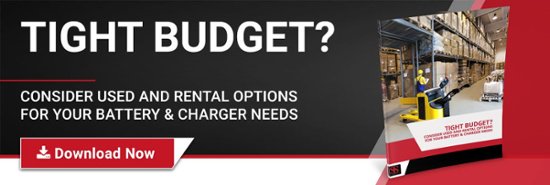As a warehouse manager, you’re probably already thinking about next year's budget. One thing that is commonly overlooked when forming a warehouse budget is ongoing service—but this could cost you big in the long run.
Proper warehouse service, which includes planned preventative maintenance, training and education, and repairs, ensures that your daily warehouse operations can continue running as efficiently and safely as possible.
However, it can be overwhelming trying to incorporate warehouse service into your 2020 budget. To help you out, we’ve compiled these tips for effectively working warehouse service into next year’s budget so this vital initiative doesn’t fall by the wayside.
Take an Inventory of Your Current Warehouse Equipment
Before you can budget for warehouse service, you need to know exactly what equipment your warehouse currently uses and how many of each type you have on hand. How many forklifts, batteries, chargers, and pallet racks are in your warehouse? How many dock doors do you have, and are there additional pieces of equipment installed on them that will need servicing too, such as door seals or shelters?
It’s essential to take an accurate, up-to-date inventory of your equipment before forming your 2020 budget, seeing as the cost of warehouse service on five forklifts and batteries would be much different than if you had 25.
Look at Historical Data
When conducting warehouse maintenance and repairs, you should always keep records and receipts. How often were you conducting planned preventative maintenance? How often did you find yourself still needing to conduct warehouse repairs? This can help you determine if you need to budget for more frequent preventative maintenance checks.
By looking at last year’s receipts, you’ll also be able to get an idea of how much you typically spend on preventative checks as well as emergency repairs. This way, you have a basic idea of how much you’re likely to spend so you can allocate your 2020 budget to cover those estimated needs.
Consider Your Growth Goals
Your current warehouse equipment inventory and historical data on the cost and frequency of planned preventative maintenance and warehouse repairs are a great starting point for your 2020 budget. However, you can’t just base next year’s budget off the past—you have to factor in your future growth goals, too.
Are you planning to introduce a new product line? Expand delivery into a new territory? Hire 10 additional employees? As your business and staff grows, so will your equipment needs. For example, to successfully introduce a new product line, you’ll likely need additional forklifts, batteries, and chargers to handle that production and shipping volume. Make sure you’re factoring in those future equipment needs because, as they’re acquired over the next year, they’ll also need to be serviced—which you don’t want to leave out of your budget.
Working with a Tight Budget?
We understand that running a warehouse is a massive and expensive task. So, if you’re working with a tight 2020 budget and are concerned about how you will be able to incorporate warehouse service, here are a few tips for reducing costs in other areas of your warehouse operations. This way, you’ll be able to allocate a larger portion of your warehouse budget to the service you need to stay efficient and effective.
- Prioritize planned preventative maintenance. Worn out or damaged equipment such as overloaded storage racks or faulty forklifts can make it difficult for your warehouse employees to do their jobs effectively and also increases the risk of injury. Planned preventative maintenance allows you to identify these issues and proactively make small repairs to broken warehouse equipment—rather than having to fully replace them or make larger, more costly warehouse repairs later on.
- Reduce energy-associated costs. By reducing energy-associated costs, you’ll be able to effectively lower the cost of your electric and utility bills. One way to do this is by building better insulation and leveraging dock doors to keep your climate-controlled air inside your warehouse, which saves you from losing money on powering your warehouse’s air conditioning system. Another is to install an automatic lightning system and additional windows for natural light. This will reduce the need to consistently power industrial light fixtures, and also lowers heat costs during the winter by utilizing the natural warmth of the sun.
- Leverage used or rental equipment and recycled batteries. Renting or buying used warehouse equipment can help your business save big on up-front costs. For example, you could purchase a used forklift or recycled batteries, or rent batteries or chargers by the day, week, month, or year. The immediate costs of used equipment or rentals are often a fraction of what it would cost to buy new equipment outright—which leaves more capital for your warehouse service 2020 budget.
- Improving warehouse storage organization. When your employees cannot find the products they’re looking for to get their job done, it causes delays throughout your warehouse. Therefore, improving your warehouse storage organization means fewer work delays and downtime that can cost you in revenue. Before you implement your 2020 budget, we recommend conducting a good cleanse to get rid of unnecessary inventory or equipment that is wasting space, and updating the layout of your warehouse to optimize space for what you truly need.
A warehouse cannot operate at a maximum level of safety and efficiency without proper ongoing warehouse service. So, it’s important that you have an adequate portion of your warehouse budget dedicated to this necessary initiative—or you risk have to use inefficient and unsafe equipment simply because maintaining them properly “isn’t in the budget.”
If you are in need of any warehouse services, or guidance as you form your warehouse budget, Southern State Enterprises is here to help! We offer an extensive, comprehensive list of warehouse services that are all performed by our expertly trained technicians. If you’re interested in increasing the safety and longevity of your warehouse equipment, therefore making the most out of your investment, contact one of our representatives today!






